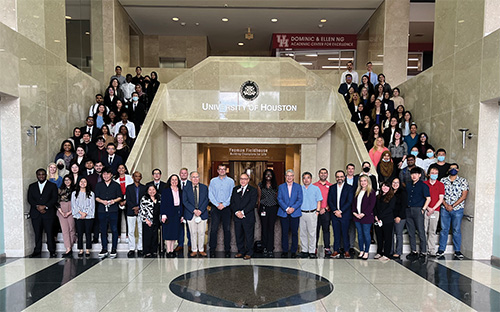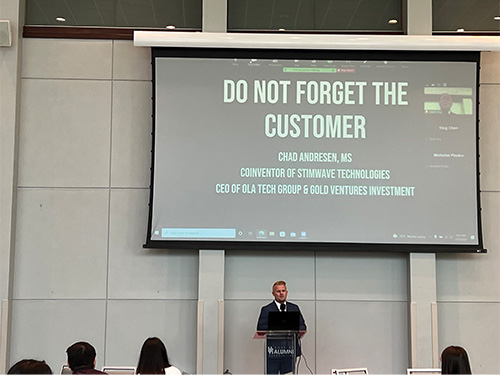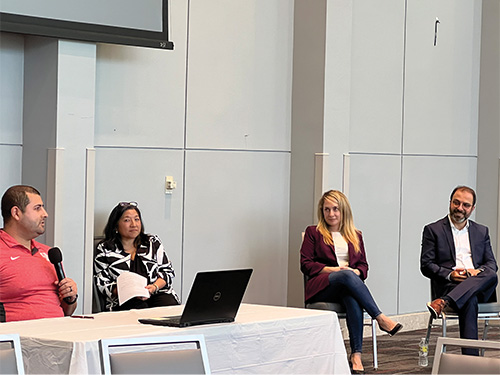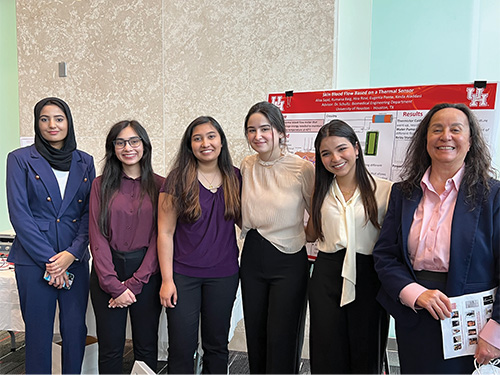The 9th Annual University of Houston BME Day on Health Care Innovations and Entrepreneurship, co-sponsored by the IEEE Engineering in Medicine and Biology Society, and technically co-sponsored by the BioHouston Inc., was held on 29 April 2022 (Figure 1).
Amidst the crowd of innovators and BME projects at UH BME Day 2022, Chad Andresen, M.S., (Figure 2) provided an inspiring keynote on innovation surrounding the medical device industry and entrepreneurship. As an inventor of over 40 patents, an entrepreneur, and an inventor at Stimwave Technologies, his innovations have changed the lives of over 10,000 chronic pain patients. He highlighted the critical aspect of entrepreneurial success with identifying the customers early on and spending time refining any innovation through the eyes of your end-customers.
As an investor and fundraiser for startups currently, Andresen confirmed that the outlook on continued investments in MedTech is bullish despite a receding market and inflation woes. When it comes to the relationship between inventors and investors, he detailed the need for founding members to provide transparency in the partnership as the company pushes forward. Founders may feel inadequate if they are not longstanding in the industry but lost to new founders is that investors are investing into the founders themselves; believing that founders will do whatever it takes to find success and exhaust all avenues.
Andresen also defined that success, a lot of times, looks like a compilation of failures coupled with a stubborn resolve to never give up. “In academia, we can spend a lot of time trying to perfect an idea as we toil for years in our labs. When these ideas meet the unknowns of the real-world patients, almost everything you assumed can be thrown out the window, in an instant! Expecting that and expediting the inputs of your end-user experience will always produce a stronger and more effective product.” He concluded his presentation with five “Founder-Mentals” that he uses to coach CEO’s and founders out of the Startup Valley of Death.
- Always move forward.
- Do not listen to haters, ignore the “it can’t be done.”
- Surround yourself with people smarter than you.
- Test quickly and often with your customers.
- Do what is right, always.
Then, Ann Tanabe, CEO, BioHouston Inc., delivered an inspiring lecture on “BioHouston and the current biotech landscape in Houston.” She indicated that Houston is home to an emerging life science cluster with much of its innovation spawning from Houston’s academic institutions. Tanabe also added that the Houston life science ecosystem is also fortunate to have local resources like JLABS@TMC, Johnson & Johnson Center for Device Innovation, the Texas Medical Center Innovation, The University of Houston Technology Bridge, and BioHouston among others, all working to help entrepreneurs and provide support to their growing companies.

Figure 1. Participants gather for a group photo at the 9th Annual University of Houston BME Day on Health Care Innovations and Entrepreneurship, co-sponsored by the IEEE Engineering in Medicine and Biology Society and technically co-sponsored by the BioHouston Inc., on 29 April 2022. Dr. Metin Akay, president of EMBS, stands with colleagues in the front row (center). (Photo courtesy of Yasemin M. Akay.)
To have a vibrant life science ecosystem, Tanabe suggested that we need companies at all stages of development. To this end, Houston is fortunate to have public companies like Castle Biosciences, LivaNova, and Lexicon Pharmaceuticals who have marketed products as well as development pipelines. Houston is also home to more than 20 companies that have received funding from The Cancer Prevention Institute of Texas (CPRIT)—a unique State of Texas agency funding academic research, product development, and cancer prevention.
Tanabe also confirmed that Houston is quickly becoming a biologics manufacturing hub for contract manufacturing and development organizations (CDMOs) and some biopharmaceutical companies. CDMO’s Lonza, Catalent, and VGXI all call the greater Houston area home, while Fujifilm Diosynth Biotechnology, Matica, and iBio are active in the College Station area. Marker Therapeutics, Kiromic, Alanuos, and Neurogene are examples of Houston-based biopharmaceutical companies with their own in-house manufacturing capabilities.
In addition, Tanabe highlighted a recent exit by Houston start-up Volumetric brought the Houston Company $45 million in upfront payment (50:50 cash and stock) with up to $355 million additional milestone payments for demonstration of additional human applications. Volumetric was acquired by 3-D Systems, a 30+ years old company that pioneered 3-D printing in the manufacturing industry. She concluded that the acquisition will establish a new 20,000 square foot facility within Houston’s East End Maker Hub and will build on an existing accelerating partnership between 3-D Systems and United Therapeutics to establish the feasibility and commercialization of bioprinted human organs.

Figure 2. BME Day Keynote Speaker, Chad Andresen, M.S. (Photo courtesy of Yasemin M. Akay.)

Figure 3. UH BME Department’s doctoral program alumni Iman Yazdi, Ph.D., a principal biomedical engineer at LiquidGlide Inc., Pinar Kanlikilicer, Ph.D., a clinical development scientist at Apellis Pharmaceuticals, and Majid Latif Jr. Ph.D., the global head of data science at Sysco, participated in a panel. (Photo courtesy of Yasemin M. Akay.)
The program continued with a panel discussion with three UH BME Department’s doctoral program esteemed alumni: Iman Yazdi, Ph.D., a principal biomedical engineer at LiquidGlide. Inc., Pinar Kanlikilicer, Ph.D., a clinical development scientist at Apellis Pharmaceuticals, and Majid Latif Jr. Ph.D., the global head of data science at Sysco (Figure 3). The panel discussion was a mix of prepared questions and questions from attendees, which focused on résumé and interviewing tips, academics and industry experience, mentors and career planning, and panelist’s experience and reflections on their careers. To start the discussion on resumes and interviewing, Majid suggested using online resume templates and noting most universities have career services that can help with resume building and review and mock interviews, and Pinar shared that background research on the company, team, and technology is a one of her key interview preparations. Finally, Iman shared that he looks for candidates that answer interview questions by sharing specific experiences that highlights the candidate’s technical skills, abilities, knowledge, and versatility relevant to the role.

Figure 4. Capstone students with Dr. Yasemin Akay. (Photo courtesy of Yasemin M. Akay.)
The conversation transition to mentorship, academics, industry experiences, and career planning. Majid started the discussion on mentors by sharing one of his favor quotes, “we all stand on the shoulders of giants.” A mentor and mentorship are quintessential in career development, and a good mentor with a focused scope can significantly increase the organic learning rate when developing technical, managerial, and leadership skills. Find a mentor that has the skills you want to learn and ask to be a mentee with the aim to learn a specific skill or accomplish an outcome.
The next question was asked by one of the BME Day attendees, “what are the differences and tradeoffs between academics and industry?” Iman responded first to be receptive to advances and opportunities and by sharing a couple of thoughts from his personal experiences as he transitioned from a research fellow at Harvard to a Senior Engineer in industry. Iman’s experience as a research fellow allowed him to leverage his technical expertise in nanomedicine, developed during his graduate studies and expanded into organ design and tissue engineering. Transitioning to industry was motivated by his curiosity to experience the development side of research and development. Iman did note career transitions do happen in both directions, and he could see himself in academics’ as well as industry setting in the future.
Pinar continued the discussion by expanding on timing and transitions. She first shared that careers are marathons not races, and we should focus on enjoying the technical work and the job itself. Also, we should not worry about time or a predefined number of years as career stages, because careers are over decades. Pinar worked in academics for more than seven years before considering a transition to industry, which was unplanned. Pinar also emphasized how her advanced degree in BME has helped her along the way, although her career path changed a little bit during her career advancement. Her Ph.D. and postdoc mentors had a great impact on Pinar’s career and helped her to build confidence with a “can-do” attitude. In addition, participating in research not only helped her to better understand the concepts by digging deep into the subject, but also helped her develop some soft skills to target and achieve goals by using critical thinking skills, time management, presenting information, problem solving, and troubleshooting.
The panelists closed the session by sharing a final piece of advice. Iman shared that life and your career will have many unexpected events and opportunities, and we should embrace change and take advantage of intriguing opportunities as they arise. Pinar focused on the importance of having a job that you enjoy in the day to day, and for everyone to not feel pressured by social norms. Do what feels right and what you enjoy, everything else will work out. Majid pushed the student to appreciate the time they have now as students, because life will only get faster as your start your career.
As you can imagine, these are only the highlights, and many more great questions were answered, and topics discussed. The session concluded with a few kind words and thanks from Dr. Akay. The final session of the day was a poster session from the senior design projects, which included image-based machine learning applications for medical screening, genomics and microarray analysis for diagnosis applications, signal processing for medical devices, and many more great projects (Figure 4).



